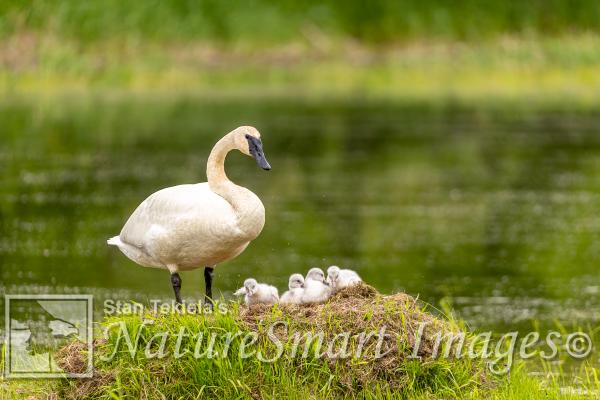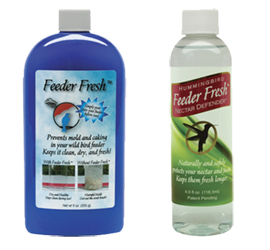View all of the titles in the
NatureSmart Bookstore

by Stan Tekiela
© NatureSmart
August 8, 2022
Recently I have been spending some time photographing a pair of Trumpeter Swans (Cygnus buccinator) with six little cygnets. This swan family is not in a wilderness setting but a suburban backyard pond. Wow, have things changed. First, when I started my career in wildlife photography 40 years ago there wasn’t any swans to be photographed let alone in a suburban backyard. They were extirpated, which is a term that means they were locally extinct. Like so many species, we humans did a great job at killing them off.
Trumpeter Swans were hunted for their meat and for their beautiful white feathers. It’s estimated that a single swan has around 25,000 feathers covering its body, many of these are tiny down feathers which have great insulation qualities. They are a large bird, standing nearly 4 feet tall and have an impressive wing span of six to eight feet. They are the largest waterfowl species and the heaviest native bird in North America. Adults can weigh 20-30 pounds.
They were heavily hunted, and it was killed off in much of the United States by the year 1900. The same thing happened to so many other species such as Eastern Turkey and Whooping Crane. Many more suffered the same fate but from different reasons. Loons, Bald Eagles, Osprey and others were also nearly wiped out due to chemicals (DDT) in the environment along with massive habitat loss.
However, with the birth of the environmental movement in the 1970's things started to turn around. Many federal laws were passed to protect these birds and other animals. At the same time, reintroduction programs were launched and many of these species have responded very quickly, and we are seeing the benefits of this combination of laws and work now.
To restore the Trumpeter Swan, eggs were taken from a wild population that still existed in Alaska and northern Canada. These eggs were hatched, and the chicks raised to adulthood. It was these adults that acted as the "seed" stock for future swans to be released. Slowly over the years, swans were released back into the wild. All these introduced birds had large neck collars with identification numbers. They found each other and started to nest and reproduce, providing a new wild population that we see today.
I recall very clearly leading a bird watching / photo tour in the early 1990's when I spotted my first Trumpeter Swan in the wild. Up until this point it wasn't possible to see a Trumpeter Swan in the wild in the upper Midwest so you can imagine just how excited my participants and I were to see this amazing bird.
These days the Trumpeter Swans are common in many parts of the country. The other day, I was photographing a pair of swans with their cygnets when a family with two young children and a dog were walking by and stopped to see what I was doing. Even though the pair of swans and 6 cygnets were about 100 feet away with my camera pointing right at the birds they didn't see what I was photographing until I told them what I was filming.
I am no longer stunned by the lack of some people’s observation skills, but what really amazes me is that I mentioned to the family that at one point in the not-so-distant past, these birds were extinct in this region and needed to be reintroduced. That means the occurrence of the swans nesting in this park is fairly noteworthy. However, the response I got from the family was they had thought that the swans were always there.
I guess, on one hand, it’s good that people think that swans are "normal". But on the other hand, if we don't understand our past or at least have some knowledge of the history, it's going to be a problem. You know what they say about history. If you don't know or understand your history, you are doomed to repeat it. Let's hope not. Until next time...
Stan Tekiela is an author / naturalist and wildlife photographer who travels the U.S. to study and photograph wildlife. He can be followed on Instagram, Facebook and Twitter. He can be reached at his web page at www.naturesmart.com.
The nationally syndicated NatureSmart Column appears in over 25 cities spanning 7 states: Minnesota, Wisconsin, Michigan, Illinois, Ohio, New York and Pennsylvania. It is a bi-weekly column circulated to over 750,000 readers.
Wolves
Just the day before, a pack of wolves known as the Wapiti, had found a large bull bison that was weak and injured. Based on its size, this big boy was near the end of its lifespan and the winter weather was taking its toll. For a full day the wolves tried to approach the bison but when the bison...
Moose
It was one of those dark and cloudy winter days in Yellowstone National Park where the clouds are so heavy and low, you feel like you can reach up and touch the cloudy sky. A light wind helped to blow the falling snow with occasional gusts of wind causing swirls of fluffy white snow...
American Badger
It’s funny, I believe the average person knows more about the Honey Badger (Mellivora capensis), a critter of Africa and Southwest Asia than they do about the badger in our own backyard, the American Badger (Taxidea taxus). Social media has a lot to do with the Honey Badger phenomena and...
Backyard Bird Feeding
Winter bird feeding is one of the most common / popular hobbies in America. It is estimated that nearly 60 million Americans feed birds in their yards in winter or summer. That is about 40 percent of all American’s make backyard bird feeding part of their everyday activities. It’s...
Each year, during June and July, Stan Tekiela offers two world-class wildlife photography tours. Here's your chance to learn some tricks of the trade from a top professional.
View all of the titles in the
NatureSmart Bookstore
Check out Stan's latest photos at
NatureSmart Wildlife Images
Do you have any interesting wildlife in your backyard? Any nesting birds, deer, turkeys, reptiles, amphibians, or other unique wildlife? Or maybe a fox or coyote den?
If so, contact Stan at stan@naturesmart.com with your backyard wildlife. If he can get a good photo of the subject, he will send you a print of the photo to hang on your wall.
Order Prints and posters of Stan's photos at
» Prints & Posters
Hear Stan on radio stations all across the Midwest.
» More Info

When he's out in the field, Stan relies on his Vortex Razor binoculars and Vortex Razor spotting scope to help find the subjects for his award winning wildlife photography.

For thirty years, professional wildlife photographer Stan Tekiela has counted on Hunt's Photo and Video to provide him with professional photography equipment.
From tripods to camera bodies and lenses, Hunt's has been Stan's place for everything that he needs. Personal service and prompt shipping means Stan can count on Hunt's to support his professional wildlife photography career.


Professional Wildlife Photographer Stan Tekiela always uses Feeder Fresh in his seed feeders to help keep the feeders and food dry, clean and mold free.
He also uses Feeder Fresh Nectar Defender in all of his hummingbird feeders. It safely keeps nectar fresh longer.